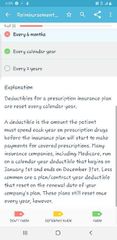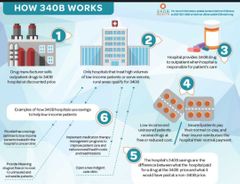![]()
![]()
![]()
Use LEFT and RIGHT arrow keys to navigate between flashcards;
Use UP and DOWN arrow keys to flip the card;
H to show hint;
A reads text to speech;
87 Cards in this Set
- Front
- Back
|
___________ fee compensates a pharmacy for transferring a drug to the patient, overhead costs, and patient counseling. |
Dispensing fee |
|
|
a patient can visit any doctor without choosing a primary care physician, and pay smaller co-pays for in-network providers but have larger out-of-pocket costs for providers outside of the network. |
PPO preferred provider organization |
|
|
examples of government sponsored health insurance programs. |
Medicare Medicaid Tricare |
|
|
insurance program that provides benefits for employees who become injured or ill as a direct result of their job. |
Worker's compensation |
|
|
Medicare covers: |
senior citizens, individuals with disabilities, and those receiving dialysis |
|
|
refers to the maximum amount that a plan will pay for generic drugs and brand name drugs that have a generic available. |
MAC max allowable cost |
|
|
parts of Medicare covers certain vaccines that are administered to a patient at a pharmacy? |
Part D |
|
|
refers to the amount of money that must be paid on an annual basis before a co-pay applies. |
Deductible |
|
|
Deductibles for a prescription insurance plan are reset every |
Calendar year |
|
|
amount the patient must spend each year on prescription drugs before the insurance plan will start to make payments for covered prescriptions. |

Deductible |
|
|
preset annual cost that must be paid by a patient before an insurance company will begin paying towards the cost of a prescription? |
Deductible |
|
|
refers to the percentage cost that a patient pays for a medication? |
Co Insurance |
|
|
parts of Medicare offers prescription drug plans? |
Part D |
|
|
four parts to Medicare benefits. |
Part A is the hospital insurance plan Part B is the medical coverage plan that covers doctor's visits, outpatient procedures, and laboratory tests, among other things. Part C is the private insurance option known as Medicare Advantage. The newest addition to Medicare is Part D, which helps pay for prescription drugs. It is optional and available to people who are enrolled in "Original Medicare" (Parts A and B) and most Medicare Advantage plans. |
|
|
Medicaid covers which of the following groups? |
covers pregnant women, individuals with disabilities, and those below a certain income level. |
|
|
parts of Medicare covers durable medical equipment (DME)? |
Part B |
|
|
any equipment that provides therapeutic benefits to a patient in need because of a medical condition or illness. These are things such as wheelchairs, hospital beds, traction equipment, canes, crutches, walkers, kidney machines, ventilators, oxygen, monitors, pressure mattresses, lifts, nebulizers, bili blankets, and bili lights. |
durable medical equipment (DME). |
|
|
refers to the coverage gap in Medicare Part D that occurs when the cost of a patient’s prescriptions in a given year exceeds a certain amount? |
Donut hole |
|
|
parts of Medicare covers nursing care and hospital stays?+ |
Part A |
|
|
strategies used by pharmacy benefit managers to contain drug costs. |
tiered co-pay structure, prior authorizations, and formulary management |
|
|
contains drug pricing information such as the average wholesale price (AWP) and suggested retail price. |
Red book |
|
|
parts of Medicare is a private insurance option that is also known as Medicare Advantage? |
Part C |
|
|
type of insurance that a consumer receives through his/her employer (or a family member’s employer) or through individual purchase. |
Private insurance |
|
|
With a ______________ co-payment arrangement, co-pays can change depending on the medication being dispensed. |
Variable |
|
|
insurance plans that are federal programs for patients who are elderly, disabled, receiving dialysis, or low-income. |
Medicare & Medicaid |
|
|
Diff between Medicare and Medicaid |
Medicaid provides health coverage for some low-income people, families and children, pregnant women, the elderly, and people with disabilities. Medicaid coverage is based on income and family size. Medicare is health coverage available to any person over the age of 65 years old, or those under the age of 65 that are receiving Social Security Disability Insurance (SSDI). Additionally, those under the age of 65 with End-Stage Renal Disease (ESRD) qualify for Medicare. |
|
|
insurance plans can a patient choose a primary care physician from a network of providers, and that physician coordinates his/her care? |
health maintenance organization |
|
|
refers to the amount of money that an individual or business must pay for an insurance plan. |
Premium |
|
|
amount that the policy-holder or their sponsor (i.e. an employer) pays to the health plan to purchase health coverage. |
Premium |
|
|
the amount that the insured must pay out-of-pocket before the health insurer pays its share. |
Deductible |
|
|
fixed, pre-arranged monthly payments made to a physician, clinic, or hospital per patient enrolled in a health plan, or per capita, by a health insurance company. |
Capitation |
|
|
T/F All prescription drug benefit plans have deductible |
FALSE |
|
|
responsible for routing prescription information from the pharmacy management software, ensuring that it conforms to NCPDP standards, and routing it to the pharmacy benefit manager. |
Switch vendor |
|
|
types of co-payment arrangement requires a set co-pay regardless of the medication received and its cost? |
Flst rate copay |
|
|
flat fee that a patient must pay to the pharmacy at the time a medication is dispensed. |
Copay |
|
|
produced by Micromedex, a healthcare brand of Truven Health Analytics. Its purpose is to allow comprehensive access to current and accurate drug pricing information, such as the average wholesale price (AWP) and suggested retail price of medications. RED BOOK has information for over 200,000 prescription and over-the-counter drugs, nutraceuticals, and bulk chemicals. |
Red book |
|
|
refers to the average purchase price of a medication at the wholesale level. |
average wholesale price (AWP) |
|
|
types of economic analysis studies the perceived benefit of a medication versus its cost? |
cost-benefit analysis |
|

|

|
|
|
When billing a third-party provider, which relationship holder code should be selected for a patient that is the spouse of the primary cardholder? |
02 |
|
|
refers to the process that requires a prescriber to obtain approval from a patient’s insurance company before a specific medication can be dispensed. |
Prior authotization |
|
|
Drug coupon cards for specific medications are provided by |
Manufacturers |
|
|
an alphanumeric number defined by a pharmacy benefit manager that appears on a health insurance card and is used as a secondary identifier for insurance claims? |
processor control number (PCN) |
|
|
extra health insurance that covers the gap in the Medicare program coverage. |
Medigap |
|
|
DAW codes should be used if no product selection is indicated? |
DAW 0 |
|
|
code is an instruction regarding substitution of generic equivalents or order to dispense the specific prescribed medication as written by the prescriber . |
DAW (Dispense as Written) |
|
|
DAW # means that no product selection is indicated. |
DAW 0 |
|
|
DAW # means substitution not allowed by prescriber |
DAW 1 |
|
|
DAW # states substitution allowed - patient requested the brand product be dispensed, |
DAW 2 |
|
|
DAW # indicates substitution allowed - pharmacist selected product dispensed. |
DAW 3 |
|
|
National Provider Identifier (NPI) is issued by |
CMS (Centers for Medicare and Medicaid Services). |
|
|
required by an insurance company when processing a prescription claim. |
patient’s name, identification number, and medication dosage |
|

|

|
|
|
refers to the process of determining which insurance coverage should be primary, secondary, etc. |
Coordination benefits |
|
|
following DAW codes should be selected if the prescriber indicates that a generic substitution is permitted, but the generic product is temporarily unavailable so the brand product is dispensed instead? |
DAW 8 |
|
|
refers to the act of processing an insurance claim or bill. |
Adjudication |
|
|
initial step that should be taken if a “Refill Too Soon” alert occurs when billing an insurance company for a prescription? |
verify that the correct days supply was entered. |
|
|
codes are used for billing medication therapy management (MTM) services provided by a pharmacist? |
CPT codes |
|
|
steps should be performed if a “Patient Not Eligible” alert occurs when billing an insurance company for a prescription? |
Verifying a patient’s name, date of birth, and person code, and checking that the correct insurance company is being billed |
|

|

|
|
|
a unique 10-digit identification number issued to health care providers to transmit health information. |
National Provider Identifier (NPI) |
|
|
a six-digit number that appears on a health insurance card and is used to identify a specific plan from a carrier. |
bank identification number (BIN) |
|
|
refers to the actual cost that a pharmacy paid for a medication. |
actual acquisition cost (AAC) |
|
|
insurance is provided by or subsidized by the government? |
Public insurance |
|
|
When billing a third-party provider, which of the following relationship holder codes is usually selected for a patient that is a child of the primary cardholder? |
03 |
|

|

|
|
|
organization that developed rejection codes that are used when billing a third-party payer. |
NCPDP |
|

|

|
|
|
What is NCPDP |
National Council for Prescription Drug Programs (NCPDP) – lead transformation in the pharmacy services sector by creating and promoting standards for electronic healthcare transactions |
|
|
Tasks of NCPDP |
• Real-time claims adjudication, eligibility and benefit verification, real-time ordering by the physician, and sharing of medication history |
|
|
How is HMO differ with other health care plan? |
cost and choice • You choose one primary care physician and all of your health care services go through that physician • Typically has lower monthly premiums with lower copays and coinsurance with no out-of- network coverage except in the case of a true emergency • Has their own network of doctors, hospitals and other healthcare provides who have agreed to accept payment at a certain level for any services they provide |
|
|
-You choose one primary care physician and all of your health care services go through that physician |
HMO |
|
|
-Typically has lower monthly premiums with lower copays and coinsurance with no out-of- network coverage except in the case of a true emergency |
HMO |
|
|
-• Has their own network of doctors, hospitals and other healthcare provides who have agreed to accept payment at a certain level for any services they provide |
HMO |
|
|
PPO definition |
Preferred Provider Organization (PPO) •More flexibility offered in selecting a doctor or hospital and sometimes covers the costs and visits to out-of-network providers • You do not need a primary care physician and are able to go to any health care professional you want without a referral •The majority of companies that offer health insurance benefits to employees offer PPO plans |
|
|
-•More flexibility offered in selecting a doctor or hospital and sometimes covers the costs and visits to out-of-network providers • You do not need a primary care physician and are able to go to any health care professional you want without a referral |
PPO |
|
|
Who provides health coverage through Medicare, Medicaid, the Children’s Health Insurance Program (CHIP) and the Health Insurance Marketplace |
Centers for Medicare and Medicaid Services (CMS) |
|
|
Task of Centers for Medicare and Medicaid Services (CMS) |
-Provides health coverage through Medicare, Medicaid, the Children’s Health Insurance Program (CHIP) and the Health Insurance Marketplace - Provides access to high quality care and improved health at lower costs - CMS is part of the Department of Health and Human Services (HHS) |
|
|
Who are eligible for MEDICARE |
Eligibility: 65 or older, younger people with disabilities, people with end stage renal disease. |
|
|
Who are eligible for Medicaid |
– state funded, low-income families and children, pregnant women, elderly and people with disabilities. Some states include dental services |
|
|
Eligible for Tricare |
Eligibility: uniformed service members and their families, national guard/reserve members and their families, survivors, former spouses, medal of honor recipients and their families and others registered in the defense enrollment eligibility reporting system (DEERS). |
|
|
MEDICARE PART A |
-helps cover inpatient care in hospitals, critical access hospitals, skilled nursing facilities (not custodial or long-term care), hospice care and some home health care if certain conditions are met - if you (or your spouse) did not pay Medicare taxes while you worked and you are age 65 and older and a citizen or permanent resident of the United States, you may be able to buy Part A - if you do not qualify for premium free Part A, the standard premium is $458 each month if you paid Medicare taxes for less than 30 quarters but if you paid Medicare taxes for 30-39 quarters the standard premium is $252 each month |
|
|
MEDICARE PART B |
Covers 2 types of services: Medically necessary services – services or supplies that are needed to diagnose or treat your medical condition and that meet accepted standards of medical practice Preventative services – health care to prevent illness or detect it at an early stage, when treatment is most likely to work best - Examples of coverage: Clinical research, ambulance services, durable medical equipment, mental health (inpatient, outpatient, partial hospitalization), limited outpatient prescription drugs - Coverage is based on 3 main factors: Federal and state laws, national coverage decisions made by Medicare about whether something is covered, and local coverage decisions made by companies in each state that process claims for Medicare - Premium amount is $144.60 each month |
|
|
MEDICARE PART C |
all in one alternative to Original Medicare (part A, B and usually D) – Original Medicare exists even if you buy up - the buy up for Part C depends on several different factors and is very similar to regular private insurance options - offered by private companies approved by Medicare - plans may have lower out of pocket costs than Original Medicare - typically will need to use doctors within the plans network - typically have access to additional benefits that Original Medicare does not cover such as vision, hearing, and dental |
|
|
Another term for Medicare Part A,B,C,D |
A Hospital Insurance B Medical Insurance C Medical advantage D Rx Drug |
|
|
MEDICARE PART D |
Each plan that offers prescription drug coverage through Medicare Part D must give at least a standard level of coverage set by Medicare Part D premiums are based on income If your income is above a certain limit, you will pay an income-related monthly adjustment amount in addition to your plan premium Premiums are typically deducted from your Social Security benefits check Late enrollment penalty could apply if, for any continuous period of 63 days or more after your Initial Enrollment Period is over, you go without a Part C or D plan or creditable prescription drug coverage Penalty is calculated by multiplying 1% of the “national base beneficiary premium” ($32.74 in 2020) time the number of full, uncovered months you did not have Part D or creditable coverage and added to your monthly premium 2 ways to get Part D coverage Buy up option Medicare Advantage Plan (Part C) |
|
|
What is 340B program? |

|

